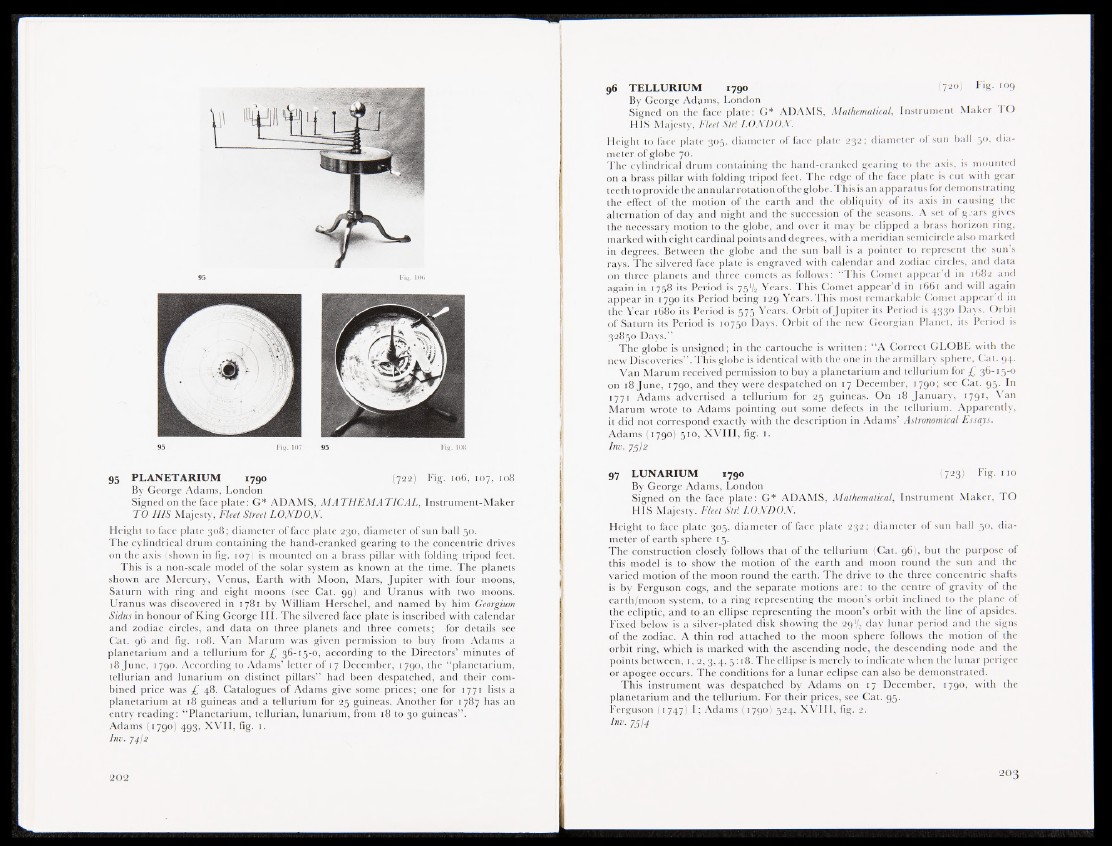
95 Fig. gffi 95 Fig. Li®
95 PLANETARIUM 1790 ;fj22) Fig. 106, 107, 108
By George Adams, London
Signed on the face plate: G* ADAMS, MATHEMATICAL, Instrument-Maker
TO HIS Majesty, Fleet Street LONDON.
Height to face plate 308; diameter of face plate 230, diameter of sun ball 50.
The cylindrical drum containing the hand-cranked gearing to the concentric drives
on the axis (shown in fig. 107) is mounted on a brass pillar with folding tripod feet.
This is a non-scale model of the solar system as known at the time. The planets
shown are Mercury, Venus, Earth with Moon, Mars, Jupiter with four moons,
Saturn with ring and eight moons [see Cat. 99) and Uranus with two moons.
Uranus was discovered in 1781 by William Herschel, and named by him Georgium
Sidus in honour of King George III. The silvered face plate is inscribed with calendar
and zodiac circles, and data on three planets and three comets; for details see
Cat. 96 and fig. 108. Van Marum was given permission to buy from Adams a
planetarium and a tellurium for £ 36-15-0, according to the Directors’ minutes of
18 June, 1790. According to Adams’ letter of 17 December, 1790, the “ planetarium,
tellurian and lunarium on distinct pillars” had been despatched, and their combined
price was £ 48. Catalogues of Adams give some prices; one fofi A71 lists a
planetarium at 18 guineas and a tellurium for 25 guineas. Another for 1787 has an
entry reading: “ Planetarium, tellurian, lunarium, from 18 to 30 guineas” .
Adams (1790) 493, XVII, fig. 1.
Inv. 74I2
96 TELLURIUM 1790 (720) Fig. I09
By George Adams, London
Signed on the face plate: G* ADAMS, Mathematical, Instrument Maker TO
HIS Majesty, Fleet Str! LONDON.
Height to face plate 305, diameter of lace plate 232; diameter ol sun ball 50, diameter
of globe 70.
The cylindrical drum containing the hand-cranked gearing to the axis, is mounted
on a brass pillar with folding tripod feet. The edge of the face plate is cut with gear
teeth to provide the annular rotation of the globe. This is an apparatus for demonstrating
the effect of the motion of the earth and the obliquity of its axis in causing the
alternation of day and night and the succession of the seasons. A set of gears gives
the necessary motion to the globe, and over it may be clipped a brass horizon ring,
marked with eight cardinal points and degrees, with a meridian semicircle also marked
in degrees. Between the globe and the sun ball is a pointer to represent the sun’s
rays. The silvered face plate is engraved with calendar and zodiac circles, and data
fin three planets and three comets as follows: “This Comet appear’d in 1682 and
again in 1758 its Period is 75V2 Years. This Comet appear’d in 1661 and will again
appear in 1790 its Period being 129 Years. This most remarkable Comet appear’d in
the Year 1680 its Period is 575 Years« Orbit ofjupiter its Period is 4330 Days. Orbit
of Saturn its Period is 10750 Days. Orbit of the new Georgian Planet, its Period is
32850 Days.”
The globe is unsigned; in the cartouche is written: “A Correct GLOBE with the
new Discoveries” . This globe is identical with the one in the armillary sphere, Cat. 94.
Van Marum received permission to buy a planetarium and tellurium for £ 36-15-0
on 18 June, 1790, and they were despatched on 17 December, 1790; see Cat. 95. In
1771 Adams advertised a tellurium for 25 guineas. On 18 January, 179L Van
Marum wrote to Adams pointing out some defects in the tellurium. Apparently,
it did not correspond exactly with the description in Adams’ Astronomical Essays.
Adams (1 790} 510, XVIII, fig. 1.
Inv. 7ji2
97 LUNARIUM 1790 (723) Fig- 95 * 110
By George Adams, London
Signed on the face plate: G* ADAMS, Mathematical, Instrument Maker, TO
HIS Majesty. Fleet Str1. LONDON.
Height to face plate 305, diameter of face plate 232; diameter of sun ball 50, diameter
of earth sphere 15.
The construction closely follows that of the tellurium (Cat. 96), but the purpose of
this model is to show the motion of the earth and moon round the sun and the
varied motion of the moon round the earth. The drive to the three concentric shafts
is by Ferguson cogs, and the separate motions are: to the centre of gravity of the
earth/moon system, to: a ring representing the moon’s orbit inclined to the plane of
the ecliptic, and to an ellipse representing the moon’s orbit with the line of apsides.
Fixed below is a silver-plated disk showing the 2972 day lunar period and the signs
of the zodiac. A thin rod attached to the moon sphere follows the motion of the
orbit ring, which is marked with the ascending node, the descending node and the
points between, 1, 2, 3,4,5:: 8. The ellipse is merely to indicate when the lunar perigee
or apogee occurs. The conditions for a lunar eclipse can also be demonstrated.
This instrument was despatched by Adams on 17 December, 1790, with the
planetarium and the tellurium. For their prices, see Cat. 95.
Ferguson (1747) I; Adams (1790) 524, XVIII, fig. 2.
I n & s l4